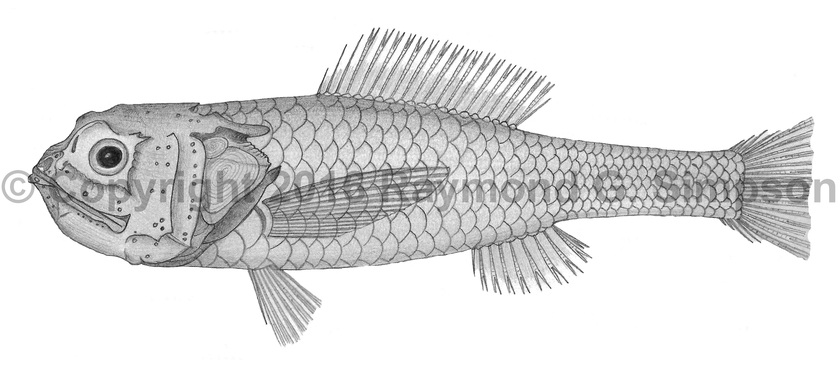
Common Name
Longfin Bigscale
Year Described
Parr, 1933
Identification
Dorsal Fin: III, 17-18
Anal Fin: I, 8
Pectoral Fin: 14-15
Pelvic Fin: I, 7
Caudal Fin: 9-10 branched, 4 procurrent rays
Lateral Scale Rows: 31-36
Gill Rakers: 17-19
Vertebrae: 28-29
Head with numerous bony ridges and pits. No post-temporal spines, projecting anterior spines, or raised bony crest on top of head. Eye diameter less than suborbital bone width. Preopercle with two weak spines at angle. Opercular margins relatively smooth or with weak spination. Gill rakers in first arch relatively few (19 or less). Anal fin origin behind last dorsal ray. Pectoral fin reaches last ray of dorsal fin. Pelvic fin origin under or slightly behind pectoral fin origin. Body scales large and easily shed. Four scales on gill cover. Spur absent on first haemal arch of caudal vertebrae.
Color
Body uniformly dark to black.
Size
Maximum size to 127mm SL
Habitat
Mesopelagic from 0-1600m. Taken near the surface at night.
Range
Tropical and subtropical Atlantic: Caribbean Sea north into the Gulf Stream to off the northeastern U.S. and George's Bank. Also off Brazil and in the eastern Atlantic.
References
Afonso, G. V. F., Di Dario, F., Eduardo, L. N., Lucena-Frédou, F., Bertrand, A., & M.M. Mincarone. 2021. Taxonomy and distribution of deep-sea bigscales and whalefishes (Teleostei: Stephanoberycoidei) collected off northeastern Brazil, including seamounts and oceanic islands. Ichthyology & Herpetology, 109(2), 467-488.
Kotlyar, A. N. 2015. Revision of the genus Melamphaes (Melamphaidae): 2. Oligo-Raker species: M. longivelis Parr, M. inconspicuus sp. n., M. kobylyanskyi sp. n. Journal of Ichthyology, v. 55 (no. 3): 311-318.
Moore, J. A., K. E. Hartel, J. E. Craddock, and J. K. Galbraith. 2003. An annotated list of deepwater fishes from off the New England region, with new area records. Northeastern Naturalist 10(2): 159-248.
Other Notes
The only other oligo-rakered species known from the western Atlantic are Melamphaes eulepis and M. inconspicuus. The former has a narrow suborbital bone and thicker, exposed head ridges. The related M. inconspicuus has fewer dorsal fin rays and vertebrae, as well as differing in many morphometric measurements (Kotlyar, 2015).